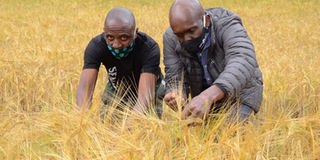How you can grow barley for high yields

Mr Gerald Asiimwe (right) a barley agronomist checks barley ears in a garden. PHOTO/LOMINDA AFEDRARU
What you need to know:
- Sowing at the right time is critical for optimising grain yield and can also influence grain quality.
- Barley is harvested when fully mature. Green seeds lower malting quality.
- Once the grain has reached 13.5 per cent or less seed moisture content, it can be harvested.
Kigezi region can best be described as a fertile swathe of land where all kinds of crops thrive – from carrots, potatoes and cabbages to tomatoes and onions.
While the crops dominate most small farms, barley growing has also taken root in the region, driven by the ready market offered by beer brewers.
Mr Gerald Asiimwe, a barley agronomist shares the best practices for the crop that has attracted hundreds of smallholder farmers.
To grow the crop, one must prepare the land well by using herbicides to kill weeds in the field, followed by ploughing and harrowing.
One acre needs some 35-40 kilogrammes of seeds, depending on the variety. The recommended fertiliser ratio is 175 kilogrammes per acre.
Land preparation
Growing of barley begins with the farmer preparing the land. A farmer is expected to clear the bush, carry out first tillage and a second tillage after two weeks before planting.
In the case of the high altitude mountainous places, land terracing is important to avoid soil erosion.
Barley can be grown on a wide range of soil types; ranging from heavy clays to light or sandy loam soils. It grows well on fertile, deep loam soils with a pH of 6 to 7.5.
Seed selection
There are a number of barley varieties grown by farmers in Uganda and these include Nguzo-hybrid type, Sabiny and Karen.
“We have introduced new high yielding varieties, including Cocktail, with yield capacity of 800 kilogrammes per hectare and Gracie variety, which yields between 1,000 kilogrammes and 1,200 kilogrammes per hectare,” says Asiimwe.
Planting
Planting date is an important factor influencing barley grain yield and quality.
There are two planting seasons for farmers in Kigezi region, with the first season being in March and the second planting season in September.
It takes three months to mature. Sowing at the right time is critical for optimising grain yield and can also influence grain quality.
Prepare the field early by removing barriers and level the ground as this helps in making a fine seeding site. Open up trenches 3-4cm deep, then thinly spread barley seeds on the walls of the trench.
A farmer may opt to use broadcast method or dig holes and plant in line where one seed is drooped in each hole with holes 15cm apart. Farmers are required to use row trenches to help in weed control.
The plant population in a field does not matter, but about 800- 1200 million plants per hectare is good enough to get good yield.
The ideal depth for planting barley is 50-75 mm deep and plant emergence may be reduced if seed is sown deeper than 75 mm.
For successful establishment, the root must continue to grow into wet soil. This means planting must be done at onset of the rainfall.
Fertiliser use
Management of nitrogen availability in the soil is vital to achieve optimal yields and quality in barley production.
At the moment, agronomists led by Asiimwe are applying fertiliser in the demonstration fields for farmers to learn from.
For farmers who can afford fertiliser, they are expected to use NPK, which must be broadcast in the farm 12 hours before planting.
Weeding
It is important for farmers to weed their farms and this can be done one and half months from the time of planting.
Alternatively farmers can use selective herbicide to kill the weeds. Framers are expected to use recommended types such as 24D.
Pests and diseases
Disease is a challenge for barley producers because it leads to yield loss as well as quality reductions.
The common foliar diseases of malting barley include fusarium head blight, net blotch and spot blotch.
The greatest degree of disease control will be accomplished using an integrated pest management strategy that incorporates genetic resistance, chemical applications and cultural control where farmers are expected to uproot affected plants.
Tillage is an effective cultural control method in reducing residue pathogens in fields where they have been an issue although disease infection is not a major challenge for farmers in Uganda.
The common pests are birds and rats, which cut off the stems.
Farmers are advised to clear the surroundings of their fields to avoid harbouring of rats. For the case of the birds they can use scarecrows.
Harvesting
Barley is harvested when fully mature. Green seeds lower malting quality. Once the grain has reached 13.5 per cent or less seed moisture content, it can be harvested.
Newly stored barley will have residual field heat and uneven dryness that might lead to moisture pockets in the bin.




